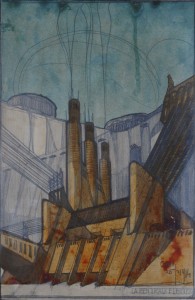
La Città Nuova: Oltre Sant’Elia
March 24 – July 14, 2013
Villa Olmo & Pinacoteca Civica, Como
Curated by Marco De Michelis
Catalog: Silvana editoriale
The exhibition will analyse a century of urban visions, as depicted in 100 works, some of them on show here for the first time, including paintings, drawings, models, films and installations by artists, architects and film directors, including Antonio Sant’Elia, Umberto Boccioni, Fernand Léger, Mario Sironi, Le Corbusier, Frank Lloyd Wright, Fritz Lang, Yona Friedman, Archizoom, Superstudio, Chris Burden, Carsten Höller and others.
A section hosted in parallel in the Civic Gallery will show 50 drawings by Antonio Sant’Elia belonging to the City of Como, which have been inaccessible to the general public for many years.
From 24 March to 14 July 2013, Villa Olmo and the Civic Gallery of Como (Italy) will be hosting an exhibition that analyses one hundred years of urban visions lasting the entire twentieth century, inspired by the drawings of Como’s illustrious son Antonio Sant’Elia (Como, 1888 – Monfalcone, 1916).
Curated by Marco De Michelis, lecturer at the IUAV University of Architecture in Venice, and organised by the City of Como Department of Culture, THE NEW CITY: BEYOND SANT’ELIA will show 100 works, some of which have never been shown before, including paintings, drawings, films and installations by artists, architects and film directors, including Antonio Sant’Elia, Umberto Boccioni, Fernand Léger, Mario Sironi, Le Corbusier, Frank Lloyd Wright, Fritz Lang, Yona Friedman, Archizoom, Superstudio, Chris Burden, Carsten Höller and others.
A section hosted in the Civic Gallery will show 50 drawings by Antonio Sant’Elia belonging to the City of Como, which have been inaccessible to the general public for many years. The exhibition is a rare opportunity to admire such a substantial number of the Como architect’s works, which considerations of conservation have rendered inaccessible to the general public for many years. The show in the Gallery will illustrate Sant’Elia’s various different architectural projects, ranging from dams, power stations and major public buildings to residential developments with external lifts, airport hangars and railway stations, all featuring his typical dynamic signature oblique lines, elliptical shapes, traffic distribution and clearing towers and multi-level roads.
The first thing visitors will encounter is The New City, i.e. the series of twelve drawings presented by Sant’Elia at the Nuove Tendenze (New Trends) exhibition in Milan in del 1914, which encapsulated the urban visions of this young Como native who had then just drawn up his manifesto for a Futurist architecture.
Ever since its advent during the nineteenth century, the metropolis has been considered to be one of the most spectacular and contradictory manifestations of the modern era, featuring unprecedented and dramatic hygienic, moral, political, cultural and functional problems that called for radical reforms in the areas of roads and transport, of housing and of the organisation of everyday domestic life.
Attempts were made to offer radical responses to these challenges by such great architects as Le Corbusier and Frank Lloyd Wright, with the extraordinary visions of the Contemporary city for three million inhabitants by Le Corbusier and Broadacre City, the ideal American city based on the single-family home and the car as means of individual transport, designed by Wright, whose large model is on show here. The future of the city was long a burning issue of the discussions and questions that agitated the neo avant-gardes in Europe, but also in the United States and Japan, until the beginning of the seventies: the Dutch architect Constant, his Franco-Hungarian counterpart Yona Friedman and the British from Archigram imagined cities suspended above the ground, whose inhabitants could organise their lives freely, not unlike what was proposed by the German Walter Jonas or the Japanese metabolist Arata Isozaki. In the tempestuous context of Europe’s 1968 upheavals, Italian groups like Archizoom and Superstudio then also developed an uncompromising critique of the capitalist city, questioning its very structure and meaning.
Since the middle of the nineteenth century, the modern city has been attracting the sometimes fascinated and often shocked eyes of generations of artists. The great boulevards of Paris packed with crowds and traffic were the undeniable stars of much of the work of the Impressionists, while the Futurist Umberto Boccioni interpreted their explosive growth in such paintings as The City Rises – a rare preparatory sketch of this work is on show here – and Mario Sironi followed suit with new cityscapes taken from outlying industrial areas. Nor were the Cubists insensitive to the suggestive growth of urban agglomerations, as demonstrated here by the oil on canvas by Fernand Léger, on loan from the Philadelphia Museum of Art. In 1926, the German film director Fritz Lang made his masterpiece Metropolis against a backdrop of visionary, expressionist scenery, while only a few years later Erich Kettelhut and Hungary’s Moholy-Nagy celebrated the luminous, febrile panorama of the contemporary city in the sequences for the film Things to Come (1936), which the artist Jan Tichy has now re-used in a spectacular three-channel video.
The exhibition ends with a series of key pieces of artistic research conducted in recent years: Pizza City, the boundless model of a city made of nothing but hundreds of toys by the American artist Chris Burden and the video by the Chinese artist Cao Fei, which depicts a city suspended in the virtual space of Second Life. In an attempt to bring the experiments conducted by the avant-gardes in the twenties together with the conditions of the present, the German artist Carsten Höller has “reconstructed” the fantastic project conceived by the Soviet architect and artist Krutikov in 1928 for a “flying city”, setting it free to waft above the skies of Como today.
The exhibition is accompanied by a catalogue published by Silvana editoriale, featuring essays by the curator and by Esther da Costa Meyer, Antonello Negri, Antonio Costa, Anna Rosellini, Jean-Louis Cohen, Aya Lurie, Mark Wigley, Manuel Orazi, Simon Sadler, Roberto Gargiani, Gabriele Mastrigli, Peter Pakesch, Paola Nicolin and Joseph Grima.
Como, March 2013